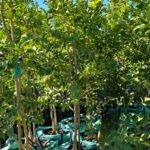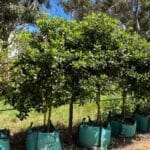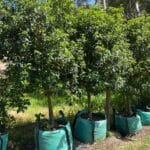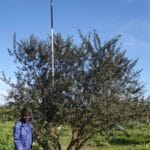Showing 1–12 of 50 resultsSorted by latest
-
Sale!

Lisbon Lemon Tree 250lt
Original price was: R7,995.00.R5,890.00Current price is: R5,890.00.Add to cartLisbon Lemon Tree 250lt
Full Sun
Afternoon Sun
Moderate WateringThe Lisbon lemon tree is a smooth skin lemon and has a thick leaf. It usually bears fruit on the inside of the tree and helps protect the fruit from different weather conditions.
They like well drained soil and full sunlight to semi shade
-
Sale!

Searsia Pendulina 250lt
Original price was: R7,000.00.R5,400.00Current price is: R5,400.00.Add to cartSearsia Pendulina 250lt
Common Name: White Karee, Rhus PendulinaFull Sun
Indigenous
Medium Watering
Wind Tolerant -

Lagertstroemia Indica White 250lt
R8,395.00Add to cartLagertstroemia Indica White 250lt
Full Sun
Afternoon Sun
Medium Amounts of Water
Monthly FeedingLagerstroemia indica, commonly known as Crape Myrtle or Crepe Myrtle, is a deciduous flowering shrub or small tree that belongs to the Lythraceae family. It is native to parts of Asia, including China, Korea, and India. The plant is popular in landscaping and gardening due to its vibrant and long-lasting summer blooms, as well as its attractive bark and foliage.
Flowers
One of the standout features of Crape Myrtles is their showy flowers. The flowers are often clustered in dense, terminal panicles and come in a variety of colours including shades of white, pink, lavender, and red. The flower clusters resemble crinkled tissue paper, which gives rise to the common name “Crepe Myrtle.”Foliage
The leaves are simple, opposite, and elliptical with a smooth or slightly serrated margin. They are green during the growing season and may turn shades of red, orange, or yellow in the fall before dropping.Bark
As Crape Myrtles age, their bark peels away to reveal a smooth, mottled texture underneath. This characteristic bark is a notable feature during the winter months when the plant is leafless.Size
Depending on the variety and growing conditions, Crape Myrtles can range in size from compact shrubs to small trees. They can reach heights of 3 to 30 feet.Cultural Requirements
Lagerstroemia indica thrives in full sun and well-draining soil. It is relatively drought-tolerant once established and can tolerate a range of soil types. Proper pruning can help maintain a desired shape and promote healthy growth.Hardiness
Crape Myrtles are generally hardy in USDA hardiness zones 7 through 9, but there are newer cultivars bred to be more cold-resistant, allowing them to be grown in zone 6 as well.Disease and Pest Resistance
Crape Myrtles are generally considered relatively resistant to pests and diseases, though they can occasionally be susceptible to issues like aphids, powdery mildew, and sooty mould. -

Lagerstroemia Indica lilac 250lt
R8,395.00Add to cartLagerstroemia Indica lilac 250lt
Full Sun
Afternoon Sun
Medium Amounts of Water
Monthly FeedingLagerstroemia indica, commonly known as Crape Myrtle or Crepe Myrtle, is a deciduous flowering shrub or small tree that belongs to the Lythraceae family. It is native to parts of Asia, including China, Korea, and India. The plant is popular in landscaping and gardening due to its vibrant and long-lasting summer blooms, as well as its attractive bark and foliage.
Flowers
One of the standout features of Crape Myrtles is their showy flowers. The flowers are often clustered in dense, terminal panicles and come in a variety of colours including shades of white, pink, lavender, and red. The flower clusters resemble crinkled tissue paper, which gives rise to the common name “Crepe Myrtle.”Foliage
The leaves are simple, opposite, and elliptical with a smooth or slightly serrated margin. They are green during the growing season and may turn shades of red, orange, or yellow in the fall before dropping.Bark
As Crape Myrtles age, their bark peels away to reveal a smooth, mottled texture underneath. This characteristic bark is a notable feature during the winter months when the plant is leafless.Size
Depending on the variety and growing conditions, Crape Myrtles can range in size from compact shrubs to small trees. They can reach heights of 3 to 30 feet.Cultural Requirements
Lagerstroemia indica thrives in full sun and well-draining soil. It is relatively drought-tolerant once established and can tolerate a range of soil types. Proper pruning can help maintain a desired shape and promote healthy growth.Hardiness
Crape Myrtles are generally hardy in USDA hardiness zones 7 through 9, but there are newer cultivars bred to be more cold-resistant, allowing them to be grown in zone 6 as well.Disease and Pest Resistance
Crape Myrtles are generally considered relatively resistant to pests and diseases, though they can occasionally be susceptible to issues like aphids, powdery mildew, and sooty mould. -

Syzygium Guineense 400lt
R8,950.00Add to cartSyzygium Guineense 400lt
Common Name: WaterpearFull Sun
Indigenous
Medium Watering
Wind TolerantSyzygium guineense, commonly known as Waterberry, Water Pear, or African Waterpear, is a species of tree belonging to the Myrtaceae family. It is native to various regions in Africa, including parts of West Africa, East Africa, and southern Africa. The Waterberry tree is valued for its edible fruits and is often found growing near water sources, such as rivers and lakes.
Appearance: Syzygium guineense is a medium-sized to large tree that can reach heights of 10 to 30m. It has a rounded crown with dense foliage.
Leaves: The leaves of the Waterberry tree are simple, opposite, and elliptical in shape. They are dark green and have a glossy appearance.
Flowers: The tree produces small, cream-colored or white flowers that are arranged in panicles or clusters. The flowers are usually not showy but are an important source of nectar for pollinators.
Fruits: The most significant feature of Syzygium guineense is its edible fruit, which is known as Waterberry or Water Pear. The fruits are small, round, and turn from green to purple-black when ripe. They have a sweet and slightly tart flavour and are enjoyed fresh or used to make jams, jellies, and beverages.
Growth Requirements: Waterberry trees prefer well-draining soil and are commonly found growing in areas with access to water, such as riverbanks and wetlands. They can tolerate both full sun and partial shade.
Uses: The fruits of Syzygium guineense are an important food source for both humans and wildlife, including birds and various mammal species. In some regions, the bark and leaves of the tree have also been used for medicinal purposes.
Wildlife Attraction: The Waterberry tree is attractive to birds and other wildlife, which feed on its fruits and disperse its seeds, contributing to its ecological significance.
-

Syzygium Guineense 200lt
R4,500.00Add to cartSyzygium Guineense 200lt
Common Name: WaterpearFull Sun
Indigenous
Medium Watering
Wind TolerantSyzygium guineense, commonly known as Waterberry, Water Pear, or African Waterpear, is a species of tree belonging to the Myrtaceae family. It is native to various regions in Africa, including parts of West Africa, East Africa, and southern Africa. The Waterberry tree is valued for its edible fruits and is often found growing near water sources, such as rivers and lakes.
Appearance: Syzygium guineense is a medium-sized to large tree that can reach heights of 10 to 30m. It has a rounded crown with dense foliage.
Leaves: The leaves of the Waterberry tree are simple, opposite, and elliptical in shape. They are dark green and have a glossy appearance.
Flowers: The tree produces small, cream-colored or white flowers that are arranged in panicles or clusters. The flowers are usually not showy but are an important source of nectar for pollinators.
Fruits: The most significant feature of Syzygium guineense is its edible fruit, which is known as Waterberry or Water Pear. The fruits are small, round, and turn from green to purple-black when ripe. They have a sweet and slightly tart flavour and are enjoyed fresh or used to make jams, jellies, and beverages.
Growth Requirements: Waterberry trees prefer well-draining soil and are commonly found growing in areas with access to water, such as riverbanks and wetlands. They can tolerate both full sun and partial shade.
Uses: The fruits of Syzygium guineense are an important food source for both humans and wildlife, including birds and various mammal species. In some regions, the bark and leaves of the tree have also been used for medicinal purposes.
Wildlife Attraction: The Waterberry tree is attractive to birds and other wildlife, which feed on its fruits and disperse its seeds, contributing to its ecological significance.
-

-

-

Quercus Palustris 250lt
R8,395.00Add to cartQuercus Palustris 250lt
Common Name: Pin OakFull Sun
Low Watering
Drought Resistant
Deciduous -

-
Sale!

Tarchonanthus Camphoratus 400lt
Original price was: R9,500.00.R7,450.00Current price is: R7,450.00.Add to cartTarchonanthus Camphoratus 400lt
Common Name: Camphor BushFull Sun
Medium Watering
Drought Resistant
Indigenous Tree
Evergreen -
Sale!

Syzygium Cordatum 400lt
Original price was: R9,500.00.R7,450.00Current price is: R7,450.00.Add to cartSyzygium Cordatum 400lt
Common Name: Water Berry, WaterberryFull Sun
Semi Shade
Indigenous
Evergreen
Medium Watering
Wind Tolerant
